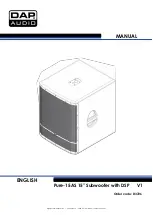
Figure 5.3
Note the relative flatness of the overall response
as well as the magnitude of your largest peak.
Some nulls are likely to be present, however fill-
ing in a null or dip with any EQ is not likely to be
effective, and the power required can make such
an attempt undesirable. If desired or necessary,
you may wish to try moving the sub to a new lo-
cation for a flatter response. Sometimes only a
few inches can make a significant difference. It's
recommended that these tests be performed us-
ing the same speaker configuration and place-
ment you'll be using while enjoying your system,
such that the interaction between the speakers
and the subwoofer can be observed. By and
large we recommend sticking with front corner
placement if possible for the benefit of the
"corner loading" increase in output, thus using
the EQ only to flatten the response.
5.3 Advanced Parametric EQ Adjustments
And the fun begins...
For this adjustment, you will need a test disc
with frequencies from at least 20Hz to 120Hz.
Stereophile Magazine and the previously men-
tioned
www.rivesaudio.com
have test discs avail-
able for sale, or you can create your own disc
with a CD writer using files found on the internet.
A web search should yield suitable tones.
Once your data is plotted as shown in figures 5.2
and 5.3 , use the Frequency (A), Bandwidth (B),
and Level (C) controls (as shown in figure 5.1) to
adjust your subwoofer’s response as follows:
A) Frequency—This control allows you to set
the exact point at which you want the CENTER of
Frequency (Hz)
30
50
80
73
67
79
the filter to be applied. In our example above,
we want to tame the peak that is centered at
just about 45Hz, and thus set our frequency fil-
ter to the corresponding 45Hz level.
B) Bandwidth—The bandwidth control on your
UFW-10 allows you to set the WIDTH of the filter
you want applied. This control is based on a
percentage of a full octave above, or a doubling
of frequency. Thus, when set to 1.0, the width
of the area you’ll be cutting or boosting will be a
full (one) octave, corresponding to an overall
width (start to finish) of double the frequency
(half above AND below your center point). In
this example, we estimate the “beginning” of the
peak in figure 5.3 to be at about 25Hz and the
“end” of the peak at about 80Hz...a range of
around 55Hz.
However, the 45Hz point is not centered in this
range. Because the EQ needs a range equidis-
tant to each side of our center frequency, set in
step 1, we have to extend our area slightly (or
move our center point...more on this later) to
fully compensate the range we require. Thus, in
this example, because we want our high point at
80Hz, or 35Hz above our 45Hz center frequency,
we also have to adjust 35Hz below our center
frequency, therefore expanding the width of our
“beginning” and “end” points to 10Hz and 80Hz
respectively (as shown in figure 5.5).
30
50
80
Center
(45Hz)
Desired Curve Width
25Hz
80Hz
Figure 5.4






























